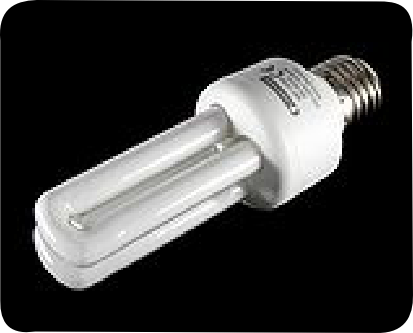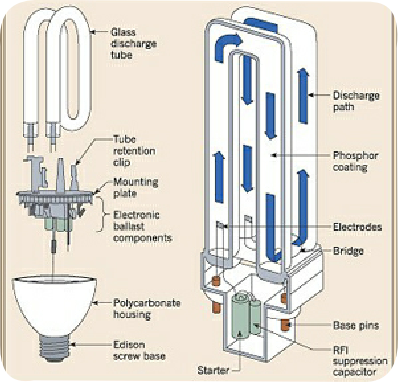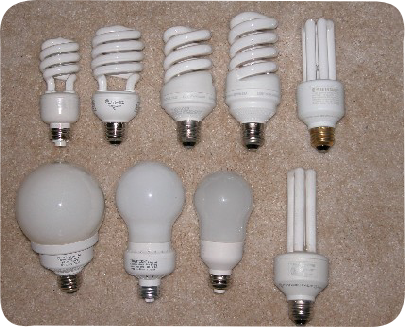



A compact fluorescent lamp ('CFL), also known as a 'compact fluorescent light or energy saving light (or less commonly as a compact fluorescent tube [CFT]), is a type of fluorescent lamp. Many CFLs are designed to replace an incandescent lamp and can fit into existing light fixtures formerly used for incandescent.
Compared to general service incandescent lamps giving the same amount of visible light, CFLs generally use less power, have a longer rated life, but a higher purchase price. In the United States, a CFL can save over US $30 in electricity costs over the lamp's life time compared to an incandescent lamp and save 2000 times its own weight in greenhouse gases. Like all fluorescent lamps, CFLs contain mercury, which complicates their disposal.
CFLs radiate a different light spectrum from that of incandescent lamps. Improved phosphor formulations have improved the subjective color of the light emitted by CFLs such that the best 'soft white' CFLs available in 2007 are subjectively similar in color to standard incandescent lamps.
The parent to the modern fluorescent lamp was invented in the late 1890s by Peter Cooper Hewitt. The Cooper Hewitt lamps were used for photographic studios and industries. Edmund Germer, Friedrich Meyer, and Hans Spanner then patented a high pressure vapor lamp in 1927. George Inman later teamed with General Electric to create a practical fluorescent lamp, sold in 1938 and patented in 1941. The modern CFL was invented by Ed Hammer, an engineer with General Electric, in response to the 1973 oil crisis. While it met its design goals, it would have cost GE about US$25 million to build new factories to produce them and the invention was shelved. The design was eventually leaked out and copied by others. CFLs have steadily increased in sales volume.
Lifespan
The average rated life of a CFL is between 8 and 15 times that of incandescents. CFLs typically have a rated lifespan of between 6,000 and 15,000 hours, whereas incandescent lamps are usually manufactured to have a lifespan of 750 hours or 1,000 hours. Some incandescent bulbs with long rated lifespans of 20,000 hours have reduced light output. The lifetime of any lamp depends on many factors including operating voltage, manufacturing defects, exposure to voltage spikes, mechanical shock, frequency of cycling on and off, lamp orientation and ambient operating temperature, among other factors. The life of a CFL is significantly shorter if it is only turned on for a few minutes at a time: In the case of a 5-
CFLs produce less light later in their life than they do at the start. The light output depreciation is exponential, with the fastest losses being soon after the lamp was first used. By the end of their lives, CFLs can be expected to produce 70-
Energy efficiency
For a given light output, CFLs use between one fifth and one third of the power of equivalent incandescent lamps. Since lighting accounted for approximately 9% of household electricity usage in the United States in 2001,[widespread use of CFLs could save as much as 7% of total US household usage.
If indoor incandescent lamps are replaced by CFLs, the heat produced by the building's lighting system will be reduced. At times when the building requires both heating and lighting, the building's central heating system will then supply the heat. If the building requires both illumination and cooling, then CFLs will use less electricity themselves and will also reduce the load on the cooling system compared to incandescent lamps. This results in two concurrent savings in electrical power.
Efficacy and efficiency
For more details on this topic, see Luminous efficacy.
A typical CFL is in the range of 17 to 21% efficient at converting electric power to radiant power. Because the eye's sensitivity changes with the wavelength, however, the output of lamps is more commonly measured in lumens, a measure that accounts for the effect of the source's spectrum on the eye. The luminous efficacy of CFL sources is typically 60 to 72 lumens per watt, versus 8 to 17 lm/W for incandescent lamps.
Cost
While the purchase price of an integrated CFL is typically 3 to 10 times greater than that of an equivalent incandescent lamp, the extended lifetime and lower energy use will compensate for the higher initial cost. A US article stated "A household that invested $90 in changing 30 fixtures to CFLs would save $440 to $1,500 over the five-
CFLs are extremely cost-

General Electric Compact Fluorescent Lamp

Breakdown of the Compact Fluorescent Lamp

Commercially available assortment of Compact Fluorescent Lamps
